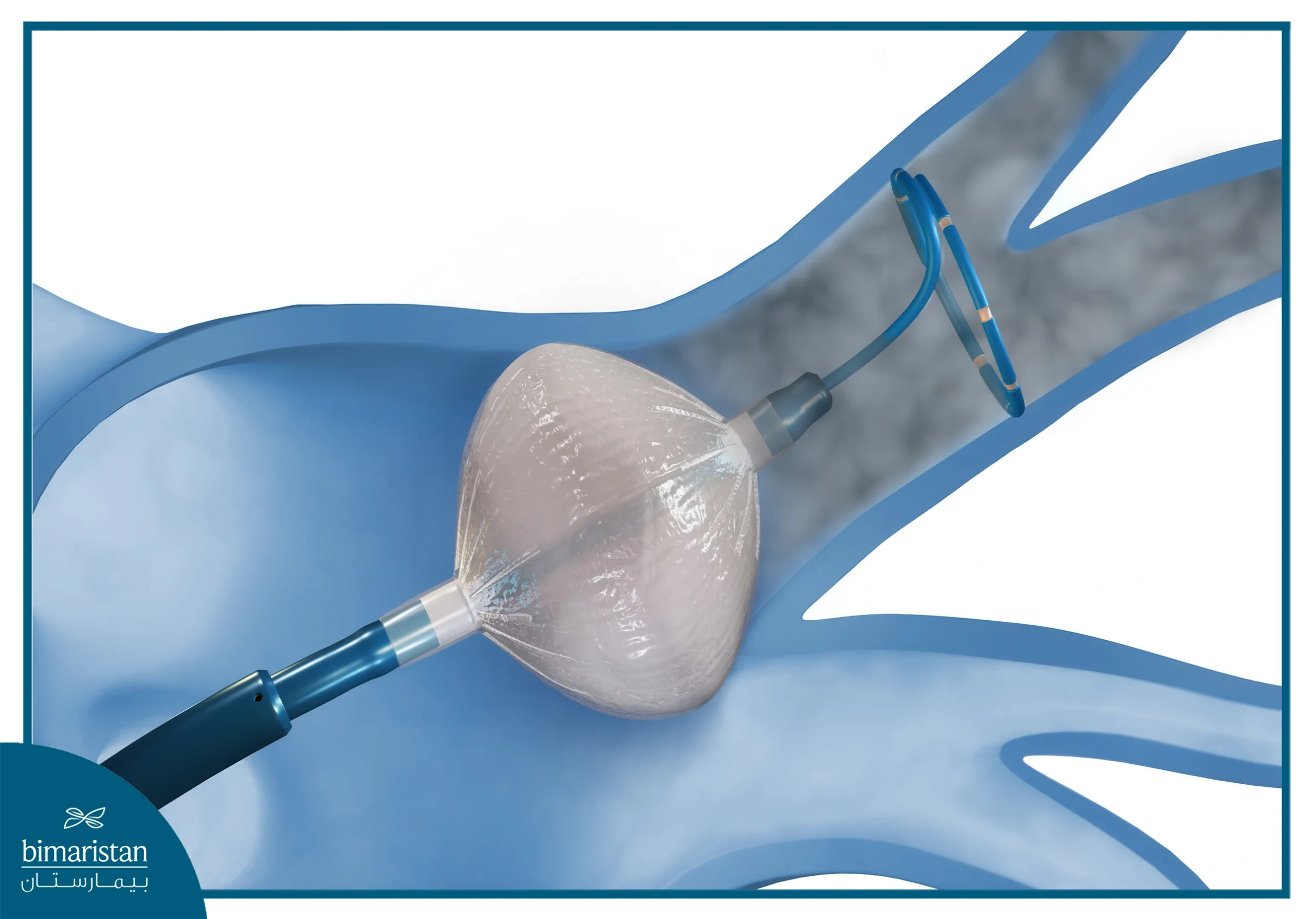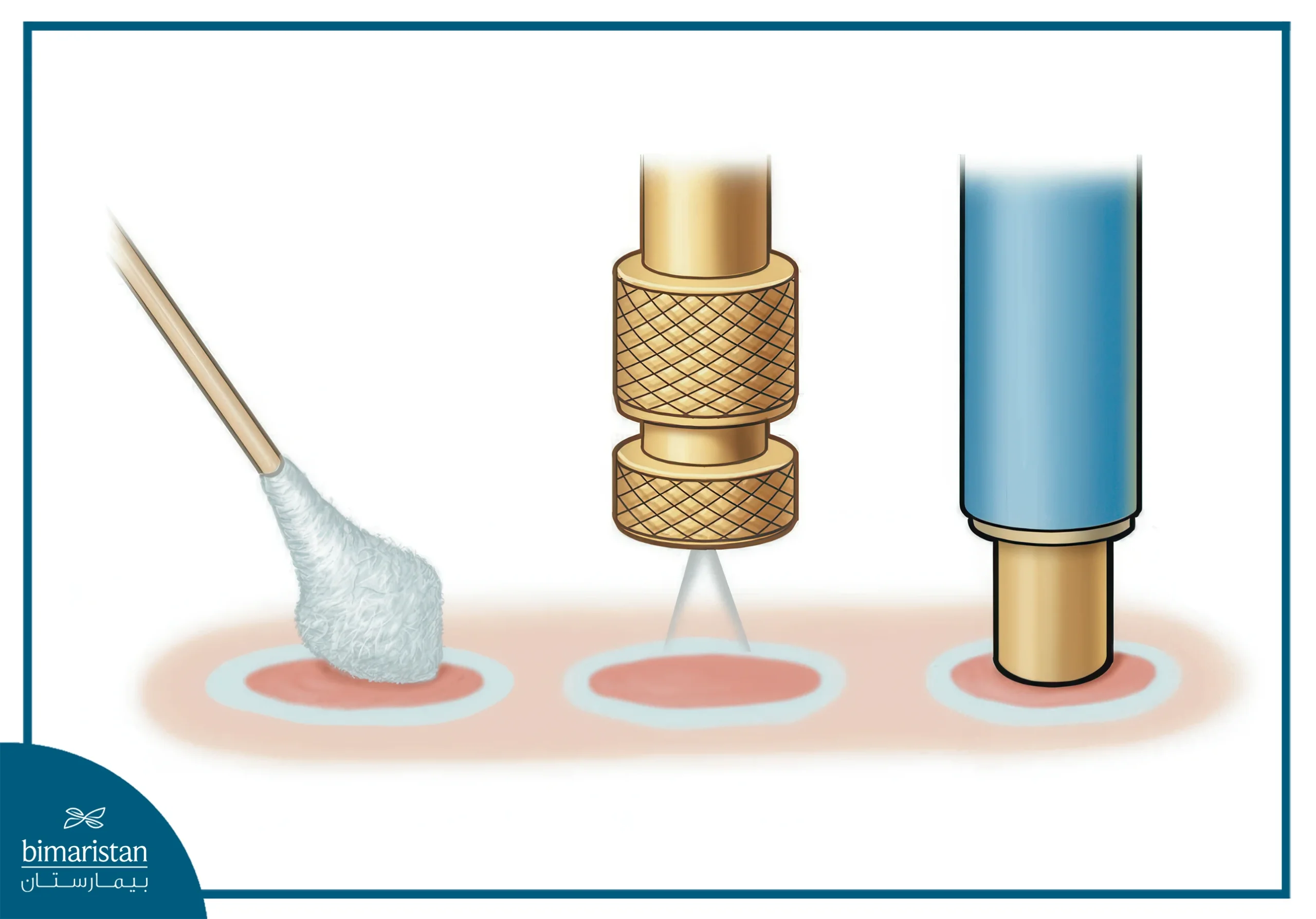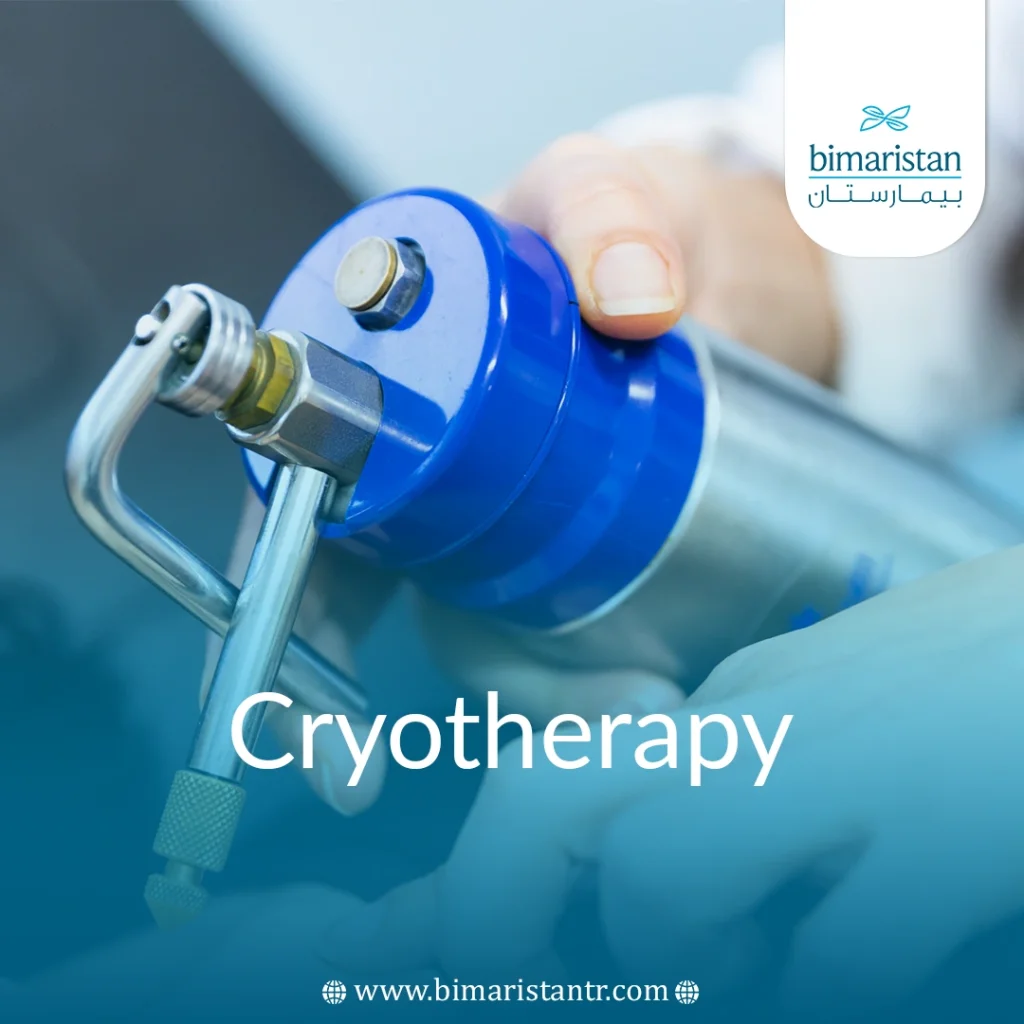Cryotherapy is a safe and effective technique for eliminating cancer by generating extreme cold to freeze and destroy cancerous tissue.
Cryotherapy can be used to treat a variety of skin conditions as well as tumors within the liver, kidneys, bones, lungs, and breast.
What is cryotherapy for cancer?
Cryotherapy cancer treatment is a modern, minimally invasive treatment that uses a needle-like instrument called a cryoprobe and liquid nitrogen or argon gas to generate extreme cold that freezes and destroys diseased tissues in the body, including cancer cells.

Cryotherapy can be applied topically (on the surface of the skin), transdermally with a needle, or surgically. Although the term cryoablation can be used, cryosurgery is often restricted to freezing cancerous tumors using only open surgery.
During cryotherapy, liquid nitrogen or high-pressure argon gas flows into a needle-like rod (cryoprobe), resulting in extreme cold that is applied to diseased tissue.
Doctors apply this treatment using imaging techniques such as USG ultrasound, CT scan, or MRI to guide the probe to the cancer sites inside the body.
How does cryotherapy work?
Cryotherapy uses nitrogen or argon gas to generate extremely cold temperatures to destroy diseased tissue.
Living tissue – whether healthy or diseased – cannot withstand this extreme cold and dies naturally as a result of:
- Ice forms in the extracellular fluid, leading to cellular dehydration.
- Ice forms inside the cell at around 40 degrees Celsius or lower, where ice crystals begin to form inside the cells and all affected cells die.
- The expansion of ice inside the cell or the contraction caused by water leaving the cell leads to its explosion and eventual death.
- Cells also die when blood flow is interrupted due to the formation of ice within the small tumor blood vessels, which causes coagulation. Since the average blood clotting time is about 10 minutes, extreme cold is maintained for at least 10-15 minutes (if not longer) to ensure that lethal ice temperatures are reached.
Some devices are equipped with a thermometer to monitor the temperature of the treated area.
Because cryotherapy consists of a series of steps that lead to cell death, tumors are frozen and thawed repeatedly and cyclically; typically, two or more thawing cycles are used.
Once the cells are destroyed, the immune system’s white blood cells work to remove the dead tissue.
Top uses of cryotherapy
Topical cryotherapy is usually used for superficial lesions, such as skin and eye lesions. When the treatment is done inside the body, a needle-like probe must be inserted through the skin tissue, sometimes requiring a surgical incision.
Cryotherapy is used to treat:
- Treating skin tumors
- To remove pre-cancerous skin moles
- For freckles
- Retinoblastoma (childhood cancer of the retina)
- Prostate cancer, liver cancer, and cervical cancer, especially if surgical removal is not possible
Cryotherapy is also used to treat tumors in other parts of the body, such as kidney cancer, bone cancer (including spinal tumors, where it helps control pain), lung cancer, breast cancer (including benign breast tumors called fibroadenomas), and pancreatic cancers.
Although more research is needed to determine the long-term effectiveness of freezing a cancerous tumor, cryotherapy has been shown to have excellent results in some carefully selected patients, and research scientists expect more promising results in the future.
Some doctors recommend a short overnight hospital stay after cryosurgery. For cryosurgery for cancerous tumors that require a large incision, a slightly longer hospital stay may be needed.
Devices used in cancer cryotherapy
In this procedure, ultrasound imaging, computerized tomography (CT), or magnetic resonance imaging (MRI) may be used for guidance. For cryosurgery, laparoscopic surgery can be performed.
If the lesion is in the lungs, a bronchoscope – a thin tube used to examine the inside of the trachea, bronchi, and other airways in the lungs – can be used. The bronchoscope can be inserted into the abdomen, and treatment can be performed directly on the lesion.
The treatment is done with a cotton swab or spray to treat the tissue outside the body.

Cryosurgery, which uses cryotherapy to treat tissue inside the body, requires image guidance and a cryotherapy instrument (cryoprobe). This device resembles a thin needle attached to a handle or a series of small needles. The cryoprobe is connected through a tube to a nitrogen or argon gas source.
Most cryotherapy units use argon gas, which has been approved by the U.S. Food and Drug Administration (FDA).
Cryoablation for cancer treatment in Turkey
The procedure is performed in Turkey under the guidance of percutaneous images by an interventional radiologist – learn more about interventional radiology cancer treatments.
Using imaging techniques, the doctor will insert one or more surgical instruments or needles into the location of the diseased tissue. Once the cryoprobe is in place, liquid nitrogen or argon gas is delivered. Regardless of the type of cryoprobe, nothing else enters the body.
A ball of ice forms at the tip of the probe due to a rapid drop in temperature, freezing all the water in the area around the tip of the probe. Imaging is used to guide the probe and monitor the freezing process.
Some tumors require multiple probes to freeze completely. For prostate cancer, six to eight probes are inserted through the perineum (the tissue between the rectum, scrotum and penis) using ultrasound guidance.
At the end of the procedure, the probe is removed, a small amount of pressure is applied to stop the bleeding, and the area is covered with a bandage. Most of the time, there is no need for sutures.
The entire procedure is usually completed within one to three hours.
What will your post-op experience be like?
There will be mild pain when the needle is inserted and the anesthetic is injected. Most of the pain after the procedure will be at the site where the needle enters the skin.
Sometimes, the procedure can be performed under general anesthesia, in which case you will be asleep during the entire procedure, and the anesthesiologist will monitor your condition. If general anesthesia is performed, the sedative medication (IV) will make you drowsy and relaxed, and then you will fall asleep and not feel anything during the procedure.
After undergoing percutaneous cryotherapy for cancer, you should be able to return to your daily activities within one to three days. If you had open cryosurgery, you should be able to resume your normal activities within seven to 10 days, and you should avoid heavy lifting for at least 72 hours.
Benefits of freezing cancer treatment in Turkey
The recovery time after laparoscopic freezing of kidney or liver tumors is less than the open surgical recovery time of the tumor.
For transcutaneous cryotherapy, the patient may stay overnight or be discharged several hours after the procedure. No painkillers are needed.
Percutaneous cryotherapy is less invasive than open surgery as only a small incision is required to pass the probe through the skin, minimizing damage to healthy tissue. Thus, freezing a cancerous tumor in the skin is less expensive and leads to fewer side effects than open surgery.
The patient can usually resume activities of daily living 24 hours after the procedure (if not sooner). However, caution about lifting weights may extend for several days after abdominal treatment.
Cryotherapy for fibroadenomas is characterized by minimal scarring and no visible calcifications after treatment.
Risks of cryotherapy for cancer
The side effects of cryotherapy are the same as in any surgical procedure; bleeding may occur as a result of puncturing and freezing tissues such as the liver, kidneys, or lungs.
- Damage to the normal structures of organs during cryotherapy occurs in both the liver and the bile duct.
- Damage to the ureter during cryotherapy.
- Rectal injury during prostate cryotherapy.
- Nerve damage: Frozen nerves can cause motor weakness or numbness in the area that the nerves supply.
- Medication-related complications, including anesthesia.
- If the procedure is in or near the lung, atelectasis may occur.
- If freezing occurs near the diaphragm, fluid can accumulate in the space around the lungs.
Any abdominal treatment can damage the intestines and cause a perforation, which can lead to the release of intestinal contents into the abdomen, resulting in life-threatening infections, but this risk is not specific to cryotherapy and is associated with any abdominal surgery.
Women should always inform their doctor or X-ray technician if there is any possibility that they are pregnant.
This procedure may involve exposure to X-rays. However, the radiation risks are not a major concern when compared to the procedure’s benefits.
The biggest concern for prostate cancer patients is permanent impotence. The freezing process can damage the nerves that control sexual function, but the nerves can regenerate a month or two after the procedure, which solves the issue for some patients.
While the patient is under anesthesia, a bladder catheter is placed to drain urine until the swelling of the bladder neck from the procedure subsides.
Crusting of the urethra may occur, which means the urethra is clogged with dead tissue. Crusting is minimized by keeping the urethra warm with sterile water continuously inserted through the catheter placed in the urethra during the procedure.
What are the limits of cryotherapy for cancer?
Cryotherapy is an alternative cancer treatment when surgical removal of the tumor is difficult or impossible for some patients, as is the case with ultrasound therapy, but its long-term effectiveness is still being studied.
Currently, there is little published data on the long-term outcomes of transdermal cryotherapy, but long-term follow-up of prostate cancer suggests that cancer control rates are comparable to surgery or radiation therapy.
Cryotherapy is a localized cancer treatment (treating the cancer in only one place). Cancer that has spread to other parts of the body cannot be treated because doctors only treat tumors they see on radiographs, so they may miss microscopic cancer.
Although its use in bone, kidney, liver, and lung is promising, transdermal cryotherapy cancer research is ongoing to determine long-term clinical outcomes.
Studies on cryotherapy for cancer
Studies on cryotherapy for lung cancer have shown that life was longer in patients in whom cryotherapy was used in combination with the use of immunotherapy or chemotherapy compared to patients in whom chemotherapy or immunotherapy alone was used in a lung cancer patient.
This is another study that shows that life span also increases in patients with metastatic breast cancers when immunotherapy is used in combination.
Another study reports increased longevity in metastatic liver cancers when cryotherapy is used in combination with other treatments.
Some studies suggest that the technology could be used to treat pain in certain musculoskeletal cancers.
Hyperthermia therapy has become an advanced option in interventional radiology treatments for cancer in Turkey, utilizing heat to target cancer cells effectively. At Bimaristan Center, we connect you with the best oncology hospitals in Turkey for cutting-edge treatment.
Cryotherapy can be considered one of the most promising methods in the field of oncology in Turkey. This method is used to treat some localized tumors when open surgery is not desired and is characterized by a quick return to normal life with fewer side effects after the operation. It may be combined with other tumor treatment modalities (radiation, chemotherapy, or immunotherapy) depending on the recommendations of the oncologist familiar with the patient’s condition. Studies are still ongoing in the field of cryotherapy in order to develop it and bring it to the largest segment of beneficiary patients.
Sources:
